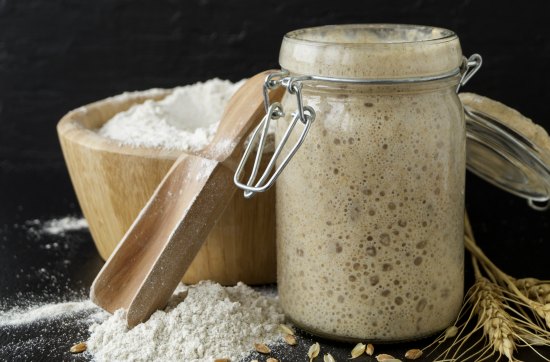Take the guesswork out of bread making with this old school trick.
In times such as these, we are all looking for simple, economic and surefire ways to sustain ourselves.
Bread is the ultimate comfort food, but given the food shortages, bread and especially yeast have become hard-to-find items at the store. I realize that a lot of people are scared right now with the pandemic crisis, but if you look around your kitchen, chances are you have what you need to sustain yourself – you just have to get creative.
Years ago, I wrote an article on 3 ways to make your own yeast and wanted to expand on that in order to help readers see how easy it is to get back to the basics. Making your own bread starter is a great way of simplifying the bread making process and there are advantages to this.

By making a starter, you significantly increase your chances of making perfect bread. The reason being is when a starter is established it already has the yeasts activated and the fermentation process naturally occurring. You can read more about the process here. As a result, once the starter gets going, you’ll never need yeast for bread again because the starter will be collecting wild yeast from the air. How cool is that?
I started researching ways of making bread with little to no yeast and wanted to share some information with all of you. I’ve made sourdough starter in the past but started reading more about how bakers get better results with their breadmaking when using boiled potato water.
1. Quicker Rise: Potatoes contain potassium which causes the yeast to rise faster than it would with breads that contain only wheat.
2. Light Crumb: When you boil potatoes, it enlarges the starch molecules. This makes it difficult for the proteins in the flour to form gluten (the enemy of light, airy bread, and pastry).
3. Moist Texture: Potato starches absorb more water than wheat starches, leading to a moist texture.
4. Longer-Shelf Life: The bread will stay soft for days thanks to the potato starch molecules’ ability to keep wheat starches from getting stale.
As I read each of the above-stated points, I was literally on the edge of my seat. That’s exactly how I wanted my homemade bread to be! So, that night I started trying a new sourdough out made with potato water. And guess what? I’ve had success every time with my bread using this starter. It’s literally no fail! And, it’s so versatile, it can used for making other baked goods like cinnamon rolls and English muffins.
Overnight Sourdough Bread Starter
- 2 potatoes, unpeeled (about the size of a large hen egg)
- 2 cups potato water
- 1 Tbsp. sugar
- 1 Tbsp. yeast
- 1 cup bread flour
- Boil potato, save potato water (unsalted).
- In a mixing bowl, add cooled potato water, sugar, yeast, and flour.
- Cover with a kitchen towel and allow the mixture to sit overnight.
- Put the mixture in a wide mouth jar and cover loosely–never use a tight-fitting lid. In about five or six days it should be ready.
- Feed starter regularly. Each time you remove a portion of the starter for a recipe, reserve at least 1/4 cup and replace the amount you have taken out with equal amounts of flour and water. I normally feed my starter 1 cup flour and 1 cup filtered water.
Once your starter has been established, its time to start baking some bread! This is my favorite bread recipe and it rises easily, has a crunchy crust, and the dough has great structure.
Basic Bread Recipe
- 1 cup bread starter
- 3 cups bread flour
- 1/2 – 1 cup water
- 2 teaspoons salt
- 1 tablespoon melted butter
- Grease bread pan and set aside.
- In a mixing bowl, add the starter and remaining ingredients and mix until combined. Note: Add water a little at a time until the consistency is right.
- Knead the dough for 5 to 10 minutes until the dough comes together. The trick is to coax the dough into a soft, smooth ball. When you begin to feel air in the mass, it’s approaching the right consistency.
- Add dough to bread pan and brush with melted butter.
- Allow bread to rise for 2-3 hours.
- Bake at 375 degrees F for 40 minutes or until bread is golden brown on top.

If you do not plan to use your bread starter, simply store it in the refrigerator. The cold temperature of the refrigerator will cause the starter to go dormant and can be left for up to three months in the fridge. When you are ready to use your refrigerated starter, take it out of the fridge and allow it to come to room temperature before use.
What is your favorite bread recipe? Help the community by leaving a recipe in the comments.
source : Tess Pennington



